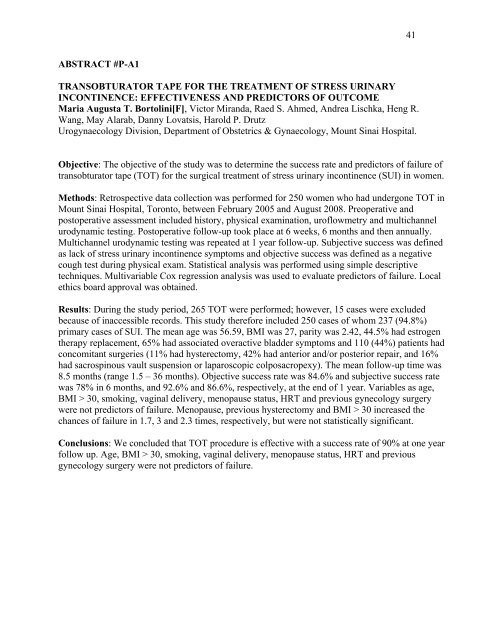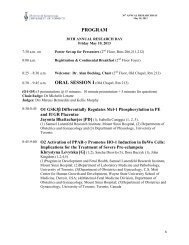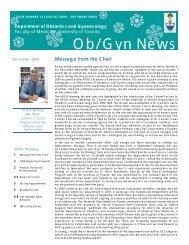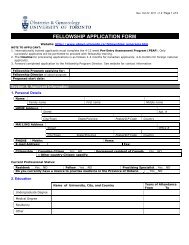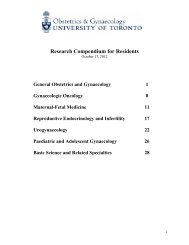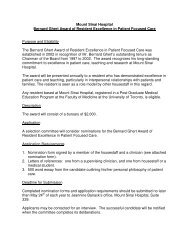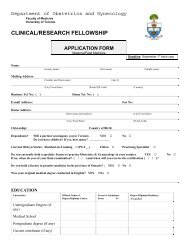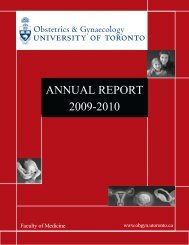research day - University of Toronto Department of Obstetrics and ...
research day - University of Toronto Department of Obstetrics and ...
research day - University of Toronto Department of Obstetrics and ...
You also want an ePaper? Increase the reach of your titles
YUMPU automatically turns print PDFs into web optimized ePapers that Google loves.
41<br />
ABSTRACT #P-A1<br />
TRANSOBTURATOR TAPE FOR THE TREATMENT OF STRESS URINARY<br />
INCONTINENCE: EFFECTIVENESS AND PREDICTORS OF OUTCOME<br />
Maria Augusta T. Bortolini[F], Victor Mir<strong>and</strong>a, Raed S. Ahmed, Andrea Lischka, Heng R.<br />
Wang, May Alarab, Danny Lovatsis, Harold P. Drutz<br />
Urogynaecology Division, <strong>Department</strong> <strong>of</strong> <strong>Obstetrics</strong> & Gynaecology, Mount Sinai Hospital.<br />
Objective: The objective <strong>of</strong> the study was to determine the success rate <strong>and</strong> predictors <strong>of</strong> failure <strong>of</strong><br />
transobturator tape (TOT) for the surgical treatment <strong>of</strong> stress urinary incontinence (SUI) in women.<br />
Methods: Retrospective data collection was performed for 250 women who had undergone TOT in<br />
Mount Sinai Hospital, <strong>Toronto</strong>, between February 2005 <strong>and</strong> August 2008. Preoperative <strong>and</strong><br />
postoperative assessment included history, physical examination, ur<strong>of</strong>lowmetry <strong>and</strong> multichannel<br />
urodynamic testing. Postoperative follow-up took place at 6 weeks, 6 months <strong>and</strong> then annually.<br />
Multichannel urodynamic testing was repeated at 1 year follow-up. Subjective success was defined<br />
as lack <strong>of</strong> stress urinary incontinence symptoms <strong>and</strong> objective success was defined as a negative<br />
cough test during physical exam. Statistical analysis was performed using simple descriptive<br />
techniques. Multivariable Cox regression analysis was used to evaluate predictors <strong>of</strong> failure. Local<br />
ethics board approval was obtained.<br />
Results: During the study period, 265 TOT were performed; however, 15 cases were excluded<br />
because <strong>of</strong> inaccessible records. This study therefore included 250 cases <strong>of</strong> whom 237 (94.8%)<br />
primary cases <strong>of</strong> SUI. The mean age was 56.59, BMI was 27, parity was 2.42, 44.5% had estrogen<br />
therapy replacement, 65% had associated overactive bladder symptoms <strong>and</strong> 110 (44%) patients had<br />
concomitant surgeries (11% had hysterectomy, 42% had anterior <strong>and</strong>/or posterior repair, <strong>and</strong> 16%<br />
had sacrospinous vault suspension or laparoscopic colposacropexy). The mean follow-up time was<br />
8.5 months (range 1.5 – 36 months). Objective success rate was 84.6% <strong>and</strong> subjective success rate<br />
was 78% in 6 months, <strong>and</strong> 92.6% <strong>and</strong> 86.6%, respectively, at the end <strong>of</strong> 1 year. Variables as age,<br />
BMI > 30, smoking, vaginal delivery, menopause status, HRT <strong>and</strong> previous gynecology surgery<br />
were not predictors <strong>of</strong> failure. Menopause, previous hysterectomy <strong>and</strong> BMI > 30 increased the<br />
chances <strong>of</strong> failure in 1.7, 3 <strong>and</strong> 2.3 times, respectively, but were not statistically significant.<br />
Conclusions: We concluded that TOT procedure is effective with a success rate <strong>of</strong> 90% at one year<br />
follow up. Age, BMI > 30, smoking, vaginal delivery, menopause status, HRT <strong>and</strong> previous<br />
gynecology surgery were not predictors <strong>of</strong> failure.


